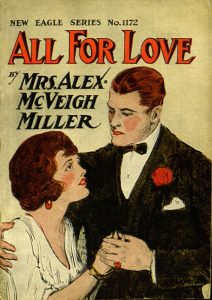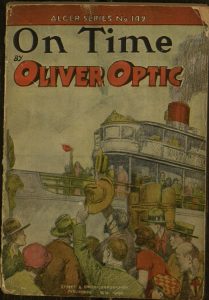eBook available: All for Love; or, Her Heart’s Sacrifice

Our latest Project Gutenberg release, drawn from our Digital Library and processed through the Distributed Proofreaders project, is another novel by Mrs. Alex. McVeigh Miller: All for Love; or, Her Heart’s Sacrifice, which had previously been serialized in the New York Family Story Paper under the title Berenice Vining’s Romance; or, Love Levels All.
The book chronicles the romance between Berry Vining, a poor and inexperienced girl who eventually becomes a successful actress and playwright, and Charley Bonair, a rich and irresponsibly flirtatious animal lover. It would not be a Mrs. Miller novel without complications, so there is a love triangle with a bloodthirsty heiress, a bear attack, a smallpox outbreak, and plenty of other twists and turns. Other interesting features of the book include a “story-in-the-story” in which Berry’s autobiographical hit play is described in great detail, and occasional hints of conscious humor (such as a recurring joke about Charley’s efforts to give up profanity) that give this a little bit of a “romantic comedy” flavor.
Like many romances of its time, the novel is very interested in class distinctions, and the theme of a romance between rich and poor is hardly a new idea. However, while many books of this type end with the revelation that the “poor” heroine was actually secretly or unknowingly rich all along, this one goes in a different direction, perhaps in an effort to differentiate this as a story in the American rather than the British mold.
If you’re interested in trying this one out for yourself, the entire book can be read online or downloaded in popular eBook formats through Project Gutenberg.








